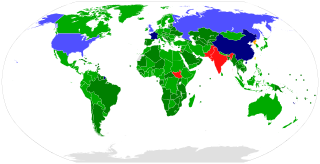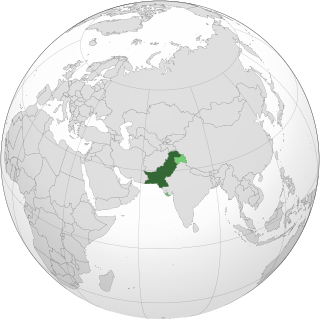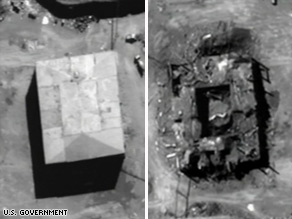
The Treaty on the Non-Proliferation of Nuclear Weapons, commonly known as the Non-Proliferation Treaty or NPT, is an international treaty whose objective is to prevent the spread of nuclear weapons and weapons technology, to promote cooperation in the peaceful uses of nuclear energy, and to further the goal of achieving nuclear disarmament and general and complete disarmament. Between 1965 and 1968, the treaty was negotiated by the Eighteen Nation Committee on Disarmament, a United Nations-sponsored organization based in Geneva, Switzerland.

Nuclear proliferation is the spread of nuclear weapons, fissionable material, and weapons-applicable nuclear technology and information to nations not recognized as "Nuclear Weapon States" by the Treaty on the Non-Proliferation of Nuclear Weapons, commonly known as the Non-Proliferation Treaty or NPT. Proliferation has been opposed by many nations with and without nuclear weapons, as governments fear that more countries with nuclear weapons will increase the possibility of nuclear warfare, de-stabilize international or regional relations, or infringe upon the national sovereignty of nation states.
The nuclear program of Iran is an ongoing scientific effort by Iran to research nuclear technology. Iran has several research sites, two uranium mines, a research reactor, and uranium processing facilities that include three known uranium enrichment plants.

Pakistan is one of nine states that possess nuclear weapons. Pakistan began developing nuclear weapons in January 1972 under Prime Minister Zulfikar Ali Bhutto, who delegated the program to the Chairman of the Pakistan Atomic Energy Commission (PAEC) Munir Ahmad Khan with a commitment to having the device ready by the end of 1976. Since PAEC, which consisted of over twenty laboratories and projects under reactor physicist Munir Ahmad Khan, was falling behind schedule and having considerable difficulty producing fissile material, Abdul Qadeer Khan, a metallurgist working on centrifuge enrichment for Urenco, joined the program at the behest of the Bhutto administration by the end of 1974. As pointed out by Houston Wood, "The most difficult step in building a nuclear weapon is the production of fissile material"; as such, this work in producing fissile material as head of the Kahuta Project was pivotal to Pakistan developing the capability to detonate a nuclear weapon by the end of 1984.

South Korea has the raw materials and equipment to produce a nuclear weapon. However, it has not opted to make one. South Korea has continued on a stated policy of non-proliferation of nuclear weapons since 2004 and has adopted a policy to maintain a nuclear-free Korean Peninsula. By contrast, North Korea has and is developing additional nuclear weapons.

Iran is not known to currently possess weapons of mass destruction (WMD) and has signed treaties repudiating the possession of WMDs including the Biological Weapons Convention, the Chemical Weapons Convention, and the Non-Proliferation Treaty (NPT). Iran has first-hand knowledge of WMD effects—over 100,000 Iranian troops and civilians were victims of chemical weapons during the 1980s Iran–Iraq War.
A nuclear fuel bank is reserve of low enriched uranium (LEU) for countries that need a backup source of LEU to fuel their nuclear reactors. Countries that do have enrichment technology would donate enriched fuel to a "bank", from which countries not possessing enrichment technology would obtain fuel for their power reactors.

The Institute for Science and International Security (ISIS) is a nonprofit, non-governmental institution to inform the public about "science and policy issues affecting international security". Founded in 1993, the group is led by founder and former United Nations IAEA nuclear inspector David Albright, and has been described as specializing "in analyzing the findings" of the IAEA. ISIS was founded on a belief that scientists have an obligation to participate actively in solving major problems of national and international security. ISIS focuses primarily on four parts: 1) prevent the spread of nuclear weapons and related technology to other nations and terrorists, 2) lead to greater transparency of nuclear activities worldwide, 3) reinforce the international non-proliferation regime, and 4) cut down nuclear arsenals. Furthermore, ISIS seeks to build stable foundations for various efforts to reduce the threat posed by nuclear weapons to U.S. and international security by integrating technical, scientific and policy research. As the effectiveness of ISIS was recognized in the Global “Go-To Think Tanks” rankings, ISIS consistently places in the top 25 Science and Technology Think Tanks in the world and in 2015 placed as one of the top United States and foreign policy think tanks in the world.
Parchin is an Iranian military complex, located about 30 kilometres (19 mi) southeast of Tehran. It is closely linked with the Khojir missile production complex.
This is the timeline of the nuclear program of Iran.

Saudi Arabia is not known to have a nuclear weapons program. From an official and public standpoint, Saudi Arabia has been an opponent of nuclear weapons in the Middle East, having signed the Treaty on the Non-Proliferation of Nuclear Weapons, and is a member of the coalition of countries demanding a Nuclear-weapon-free zone in the Middle East. Studies of nuclear proliferation have not identified Saudi Arabia as a country of concern. Nuclear technology company IP3 International was formed in June 2016 to transfer nuclear technology from the United States to Saudi Arabia.

The State of Israel is widely believed to possess nuclear weapons. Estimates of Israel's stockpile range between 80 and 400 nuclear warheads, and the country is believed to possess the ability to deliver them in several methods, including by aircraft, as submarine-launched cruise missiles, and via the Jericho series of intermediate to intercontinental range ballistic missiles. Its first deliverable nuclear weapon is thought to have been completed in late 1966 or early 1967; which would make it the sixth country in the world to have developed them.

Operation Outside the Box, also known as Operation Orchard, was an Israeli airstrike on a suspected nuclear reactor, referred to as the Al Kibar site, in the Deir ez-Zor region of Syria, which occurred just after midnight on 6 September 2007. The Israeli and U.S. governments did not announce the secret raids for seven months. The White House and Central Intelligence Agency (CIA) subsequently confirmed that American intelligence had also indicated the site was a nuclear facility with a military purpose, though Syria denies this. A 2009 International Atomic Energy Agency (IAEA) investigation reported evidence of uranium and graphite and concluded that the site bore features resembling an undeclared nuclear reactor. IAEA was initially unable to confirm or deny the nature of the site because, according to IAEA, Syria failed to provide necessary cooperation with the IAEA investigation. Syria has disputed these claims. Nearly four years later, in April 2011 during the Syrian Civil War, the IAEA officially confirmed that the site was a nuclear reactor. Israel did not acknowledge the attack until 2018.

Syria and weapons of mass destruction deals with the research, manufacture, stockpiling and alleged use by Syria of weapons of mass destruction, which include chemical and nuclear weapons.

Iran's nuclear program is made up of a number of nuclear facilities, including nuclear reactors and various nuclear fuel cycle facilities.

Bulgaria has developed weapons of mass destruction, most notably chemical weapons. Chemical weapons production was concentrated in Smyadovo. As of 2016, Bulgaria does not possess any weapons of mass destruction.
President Adly Mansour announced on 7 November 2013 that Egypt was restarting its nuclear power program in El Dabaa; a deal was reached with the residents in which it was agreed that a residential area will also be built. The Egyptian minister of electricity, Ahmed Emam, has called the project "necessary" because of a small amount of renewable energy sources and not enough fuel.
This timeline of nuclear weapons development is a chronological catalog of the evolution of nuclear weapons rooting from the development of the science surrounding nuclear fission and nuclear fusion. In addition to the scientific advancements, this timeline also includes several political events relating to the development of nuclear weapons. The availability of intelligence on recent advancements in nuclear weapons of several major countries is limited because of the classification of technical knowledge of nuclear weapons development.

The Republic of Kazakhstan, once a republic of the Soviet Union, was a primary venue for Soviet nuclear weapon testing from 1949 until 1989. Following the collapse of the Union of Soviet Socialist Republics (USSR) in 1991, Kazakhstan became the fourth-largest nuclear power in the world and hosted a considerably large weapon support infrastructure due to its reliance on the Soviet nuclear program as a means to develop its own local economy. Besides the nuclear program, Kazakhstan was also a prominent site of Soviet programs of biological and chemical weapons.
The Es-Salamresearch reactor, also known as the Aïn Oussara nuclear reactor is a nuclear research reactor in Algeria. The reactor can produce 15 megawatts-thermal and its primary uses are radiopharmaceutical production, neutron activation analysis, neutron radiography, and training. The reactor was supplied by China and built in the region of Aïn Oussera, nearly due south of the capital city of Algiers. It reached criticality in February 1992 and began operation in late 1993.










